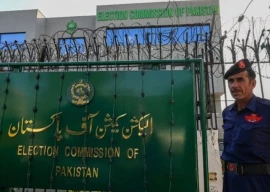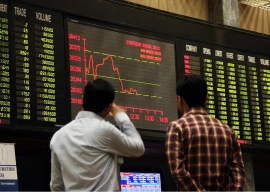
How to apply for a student visa for the US
Part(l)y in the USA
Some Pakistani students turn the same shade as the colour of their passports when they start thinking about getting a US visa. But the truth is that horror stories are actually few and far in between. “My entire visa process took two-and-a-half weeks and I didn’t apply particularly early either,” says Rabail Habib, who is studying film at Northwestern University, “I got an interview date for the week after I applied. They told me my visa was approved at the interview and I picked it up just three days later.”
The only irritant in her experience was getting roasted in the sweltering heat as she waited in line outside the US Embassy in Islamabad. “But the people at the embassy were great,” she says.
Yours form-ally
The process of applying for a visa is a fairly simple one: there are several visa categories and the first thing you need to do is pick the right one. Students enrolled in an undergraduate, Master’s or PhD programme usually need an F-1 visa to set foot on US soil. Exchange students and those planning to embark on a short vocational course must apply for other categories. Here we’ll discuss how to apply for an F-1 visa.
Once you accept the admission offer made to you by a university, their international office should send you what is known as the I-20 form. This is perhaps the most important piece of the visa puzzle. The form is proof that you have indeed been offered a spot at a US university. It also includes how much cash is required for the duration of your studies and the amount you told the university was in your bank.
You don’t need to fill this form — this will be done by the university. The most important item in this document is the SEVIS number, a unique pin through which the Office of Visa Service can access all your university information on an online database.
Once you have your I-20 and the SEVIS number, you can begin filling out the main form called DS-160, the link for which can be found on the US consulate’s website. Tree-huggers rejoice — there are no paper forms. At the login page, you will be issued an application ID number: save this, as it is needed to access your online application later.
Once you hit the submit button, you will have to pay $160 and print out the confirmation. Next, head over to your local American Express office with the items mentioned in our checklist (see Checklist) and schedule an appointment for an interview. They are conducted at the US Consulate in Karachi and the US Embassy in Islamabad.
If you don’t have a clue, no visa for you
Quite a few students underestimate how important it is to be able to explain your study plans at the visa interview. “My experience was quite embarrassing. I went in there and must have sounded like I was high,” says a girl who was denied a visa in 2010, “When the interviewer asked me why I had chosen to study economics, I just didn’t know what to say. I told them it’s because I want to ‘take on the reins of my family business’ or something lame like that. I could have sworn the interviewer rolled her eyes. I didn’t get the visa in the end.”
The bottom line is that you must be ready to explain your study plans and the reason why you applied to your particular university.
How to apply for a student visa for the UK
Beware of the Tier 4
Do not think of the tier 4 — the name of the category to which students must apply — as your enemy. Embrace it like an old friend. The documents available on the UK Border Agency (UKBA) website are daunting. After reading the first couple of pages it gets confusing but just remember to take a deep breath and keep going.
A UK visa application works on a point-based system and you get points for submitting certain documents.You need a total of 40 points to show that you are a genuine student — these include the 30 points you get by submitting the Confirmation of Acceptance for Studies (CAS) letter from your university. You can get the remaining 10 points by proving that you have enough money in the bank.
Once you get your acceptance letter, apply immediately. Do not waste time. The first thing you need to do is to make an appointment at the International Organistaion for Migration (IOM) for the TB test. The website will suggest that you call and make an appointment but it is better to email. You will end up spending a couple of hours at IOM but will get the test results the same day.
Next you need to fill out an online application available on the UKBA website. This will contain questions such as name, date of birth, where you will study, if you have a criminal record, if you’ve ever been rejected for a visa etc. After you submit this, you will be able to make an appointment to submit supporting documents.
Don’t forget to fill out the Appendix 8 application. You will need to submit that with your supporting documents. This will also be available on the UKBA website. Remember to keep your current passport and previous passports along with photocopies. You’ll also need one passport photo, but just keep two to be on the safe side.
Make sure your university sends the CAS letter on time. This has their sponsorship number and other details — which you will need for Appendix 8.
The bank statement should be your biggest concern. The UKBA is not interested in the entire year’s statement; they just want to know that you have the money in your account and have had it 30 days before you applied for the visa. Make sure you have enough money in the account to cover fees, rent and living expenditure. This could be a minimum of £25,000 if you will be living in London.
The day before you have to submit your papers, remember to take a bank draft of the exact amount for the visa fees, cash is also acceptable. Remember additional supporting documents will always help your case. Previous school transcripts are necessary. If your family has any property or extra income, do include the papers just to show that you are financially sound.
After the visa officer checks all your documents and puts them in a black plastic bag, they will direct you to the biometrics section. With that done, the officer will hand you a receipt and tell you to wait for a call.
Words of wisdom
Despite the simplicity of it all, there can be snags, so you need to apply well in advance. “Applying for a student visa was stressful and annoying,” says Alai Naseer, who is studying film in London, “I didn’t receive it until after my first term had ended. And that’s despite applying from London.”
Tips and advice
- Apply three months before the start date of your course — typical processing times span up to 60 days.
- Book your ticket once you have the visa in hand to avoid cancellation charges which may arise if there are any administrative delays in visa processing.
- One student’s experience shows that applying for programmes such as systems security and nuclear engineering could lead to delays. The student had to ask a professor whom he had done research work to write a special note to the embassy, assuring that the only reason he wanted to enroll in that programme was purely academic. This eventually helped the student get a visa.
- If at the end of the interview you are told that your visa requires further administrative processing, ask your university’s admissions office to write to the US Embassy or the consulate. One applicant claims this helped expedite the process.
- You can’t appeal a visa denial. So if rejected, have to apply again, which costs more time and money. So make sure you submit a complete application in the first go and can explain why you’re planning to study a specific course at a particular university.
- Some students have been caught off-guard, assuming that old visa rules were in place. Make sure you are familiar with the latest rules.
Mythbusters
- Are you worried that your high school is too obscure? Officials at the US consulate in Karachi deny this matters. “Visas are always based on an individual’s eligibility — and not on the school the applicant attends here in Pakistan,” says an official from the consulate. One of the key factors that help a student with their visa process is an actual plan of study.
- Another myth is that certain names, such as ‘Osama’ or ‘Khan’ might be on some sort of blacklist and applicants with such names will be scrutinised more. “There are no ‘blacklisted names’,” say consular officials in Karachi. “Some visa applications require further administrative processing, which takes additional time after the visa applicant’s interview.”
- One myth surrounds the length of the interview. In the corporate world, job interviews that are short and end abruptly are taken as bad news. This rule does not apply for US visa interviews. Most of the successful applicants who shared their experiences said they were stunned how quickly it went by. You’ll spend more time in the waiting lounge than in the interview.
US Visa Checklist
At the American Express office, you must submit:
- Your confirmation of the submission of the DS-160 form.
- A passport photo with a white background.
- A photocopy of the passport valid for the length of the trip to the US and photocopies of the passports held during the last 15 years
- Your complete travel history for the past 10 years
- The full names of your siblings, and if you’re a Master’s or PhD applicant with children, their names are required too
- Take the following documents with you to the interview:
- Your interview appointment packet with one copy of the interview letter
- Your current passport as well as any old ones you’ve travelled on
- A completed DS-160 form with a printout of the confirmation of submission page
- Original school report cards, Matric and FSc documents, O’ and A’ Level certificates, university transcripts and university degree
- Four 2x2 passport photos
- Financial documents such as bank statements and tax return forms to show that you have enough money to cover the expenses stated on the I-20 form
UK Visa Checklist
- Make an appointment to be tested for TB at the International Organisation for Migration (http://www.bia.homeoffice.gov.uk/countries/pakistan/applying/tb-testing/).
- Fill out the online application (http://www.ukba.homeoffice.gov.uk/visas-immigration/studying/) and keep a printout as proof. Once you submit the application you can make an appointment to submit your papers.
- Remember to fill out Appendix 8 (http://www.ukba.homeoffice.gov.uk/sitecontent/applicationforms/visas/vaf9-app81.pdf)
- Current and previous passports.
- Two passport photos.
- Acceptance letter and a letter from the university for visa purposes.
- Bank statements. Make sure they are up to date. Do not give entire year’s account, just 30 days prior to applying for the visa.
- Visa application fees.
- CNIC
- Keep photocopies of all original documents
- If you need supporting documents, take family financial/property papers, A’ and O’ level and other school transcripts
- One copy of the interview letter
- Your current passport as well as any old ones you’ve travelled on
- A completed DS-160 form with a printout of the confirmation of submission page
- Original school report cards, Matric and FSc documents, O’ and A’ Level certificates, university transcripts with all courses taken with grades obtained and a university degree
- Four 2x2 passport photos
- Financial documents such as bank statements and tax return forms to show that you have enough money to cover the expenses stated on the I-20 form
Published in The Express Tribune, Sunday Magazine, May 26th, 2013.
Like Express Tribune Magazine on Facebook to stay informed and join the conversation.


















COMMENTS
Comments are moderated and generally will be posted if they are on-topic and not abusive.
For more information, please see our Comments FAQ